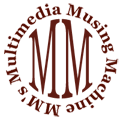Recently, a colleague shared an NPR story with me about how the Charlotte Symphony Orchestra had commissioned composer Mason Bates to write a very short "sonic logo" to be played by the orchestra. The story begins by connecting this to iconic logo sounds like the NBC and Netflix signatures which are really just a few gestures - less themes than motives. (The generic Netflix one barely qualities as a motive as there's really not much to it. It is iconic by the brute force of its ubiquity.) You may hear Bates' final product here:
It's totally fine. It does sound, to me, more like the short intro to an evening news show than something I'd associate with going to the symphony; and, even at seven seconds, it's definitely something different in scale from the Netflix and NBC "logos." Since Bates is writing something to serve as the signature for an entire orchestra, he obviously wanted to capture a big symphonic sound, but it's maybe a bit too busy to sound like a sonic logo - and yet a little too amorphous to seem like a satisfying composition.
Anyway, I couldn't help but think this was an interesting challenge - not so much to write an NBC/Netflix style logo as to write a seven-second composition. Again, this kind of thing is common enough as intros for news programs and accompaniment to production company logos, etc. But I figured it would be fun to be restricted to such a short time span - and yet still find a way to showcase the sound and scope of a full symphony orchestra. I've also already used this (minus the symphonic sound) as a challenge in my Digital Music Production class, although the first batch of student outputs are missing the kind of strong beginning-middle-end structure that I'd hoped to get.
Two days later, I have produced something for the little virtual orchestra that lives in my computer. One possible criticism I might have of Bates' Charlotte logo is that it honestly sounds pretty canned - I feel like with modern virtual orchestras, it would be quite easy to reproduce it without using a human. Since I have NOT been hired by a professional orchestra to record what I write, I'm not ashamed to say that I embraced the kind of thick, busy texture in which it is easiest to hide from reality.
The result is a little more Hollywood than I'd hoped, and in fact I accidentally ended in a way that recalls the magnificent theme (the part at 0:20 here) from The Magnificent Seven. But I like it. It's pretty difficult (impossible?) to avoid ending up with something that sounds like a fragment of something bigger, but I still think it kind of works on its own. As a visual, I paired it with a simple animation of my blog's title, so now I've got my own blog logo to use for....I have no idea what purpose.
P.S. The blog post title is actually a reference to a basketball team (early 2000s Phoenix Suns) which pioneered a particularly fast-paced approach to the already fast-paced game.
P.P.S. Another example of a micro-composition (in this case, coming in at a luxurious 20 seconds) is this quirky reworking of the primary melodic motive from "Happy Birthday." If you can hear "Happy Birthday" here - good for you!






No comments:
Post a Comment